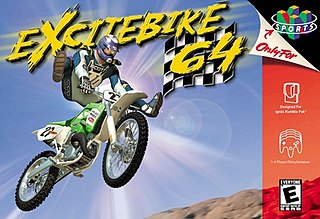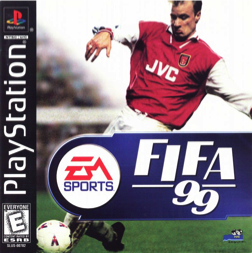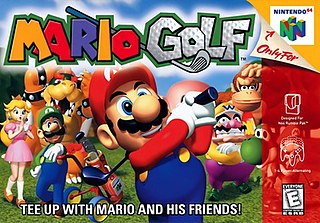
Mario Tennis is a 2000 sports video game developed by Camelot Software Planning and published by Nintendo for the Nintendo 64 (N64). Following Mario's Tennis, it is the second game in the Mario Tennis series. The game is known for being the introduction of Luigi's arch-rival, Waluigi, and the re-introduction of Princess Daisy and Birdo.

Donald Duck: Goin' Quackers is a 2000 platform game developed and published by Ubi Soft for various consoles and Windows-based personal computers. A version with the same title was released for the Game Boy Color, before it was retitled Donald Duck Advance for the Game Boy Advance. Reviews praised the music, backgrounds and animations, noting the short length and low difficulty as more fun for children.

Pokémon Stadium, known in Japan as Pokémon Stadium 2, is a strategy video game developed and published by Nintendo for the Nintendo 64. It was released in Japan on April 30, 1999; in North America on March 6, 2000; in Australia on March 23, 2000; and in Europe on April 7, 2000. It was the first Stadium title released in Western regions, succeeding the Japan-only 1998 Nintendo 64 release Pocket Monsters' Stadium. The gameplay revolves around a 3D turn-based battling system using the 151 Pokémon from the Game Boy games Pokémon Red, Blue, and Yellow.

Excitebike 64 is a racing video game developed by Left Field Productions and published by Nintendo for the Nintendo 64. It was released on May 2, 2000 in North America, June 23 in Japan, and June 8, 2001, in Europe. It is the second installment in the Excite series, acting as a sequel to Excitebike on the NES, and is the first 3D game in the series. Many real-life dirt bike gear brands are extensively featured throughout the game, such as Bell Helmets, Alpinestars and No Fear.

Ready 2 Rumble Boxing is a boxing video game developed by Midway Studios San Diego, and published by Midway in September 1999 for the Dreamcast. Ports for Nintendo 64 and PlayStation were developed by Point of View and released in November 1999 alongside a separate version for Game Boy Color by Crawfish Interactive. The success of the Dreamcast version led to it becoming one of the few Sega All Stars titles.
1998 saw many sequels and prequels in video games, such as F-Zero X, Marvel vs. Capcom, The Legend of Zelda: Ocarina of Time, Resident Evil 2, Metal Gear Solid, Glover, Crash Bandicoot: Warped, Street Fighter Alpha 3, Gex: Enter the Gecko, Fallout 2, Return to Krondor and Tomb Raider III, along with new titles such as Banjo-Kazooie, Dance Dance Revolution,Half-Life, MediEvil, Radiant Silvergun, Spyro the Dragon, StarCraft and Xenogears.

Ogre Battle 64: Person of Lordly Caliber is a real-time tactical role-playing game developed by Quest Corporation and published by Nintendo for the Nintendo 64. Atlus released the game outside Japan. Though conceptually similar to Ogre Battle: The March of the Black Queen, significant gameplay tweaks were implemented to change the game's overall flow. Ogre Battle 64 is the third game in the series, the first two being Ogre Battle: The March of the Black Queen, and Tactics Ogre. Gaidens have been released in Japan, on Game Boy Advance and Neo Geo Pocket Color. Unlike earlier Ogre Battle games, which feature Queen song titles, "Person of Lordly Caliber" is an original title. Ogre Battle 64 was released in PAL regions for the first time via the Wii Virtual Console in 2010.

Fighting Force is a 1997 3D beat 'em up developed by Core Design and published by Eidos. It was released for PlayStation, Microsoft Windows, and Nintendo 64. Announced shortly after Core became a star developer through the critical and commercial success of Tomb Raider, Fighting Force was highly anticipated but met with mixed reviews.

Penny Racers is a racing game for the Nintendo 64. It was released in Japan in 1998 and in North America and Europe in 1999. The game is part of the racing game series Choro Q based on Takara's toy line of the same name and was the first of this line to be released in North America. It had a Nintendo 64 sequel released only in Japan, Choro Q 64 2: Hachamecha Grand Prix Race. It is a customizable racer game, and has a total of 114 parts, arranged in eight categories.

FIFA 99 is a football simulation video game developed by EA Canada and published by Electronic Arts under the EA Sports label. It is the sixth game in the FIFA series and was released in 1998 for Microsoft Windows, PlayStation and Nintendo 64.

NBA Live 99 is the fifth installment of the NBA Live video games series. The cover features Antoine Walker of the Boston Celtics. The game was developed by EA Sports and released on November 4, 1998, for the Nintendo 64, and then on November 10, 1998, for the Windows and PlayStation. Don Poier is the play-by-play announcer. It was the first NBA Live game released for Nintendo 64. NBA Live 99 was followed by NBA Live 2000.

Kirby 64: The Crystal Shards is a 2000 action-platform game developed by HAL Laboratory and published by Nintendo for the Nintendo 64 (N64). It is the first Kirby game to feature 3D computer graphics and follows Kirby as he attempts to reassemble a sacred crystal shattered by Dark Matter. Gameplay is viewed from a 2.5D perspective and is similar to previous Kirby titles; the player traverses levels and obtains powers by eating enemies. Kirby 64 introduces Power Combos, the ability to mix powers to create more powerful ones. In a multiplayer mode, up to four players can compete in three minigames.

Mario Golf is a 1999 sports game developed by Camelot Software Planning and published by Nintendo for the Nintendo 64. Mario, his friends, and his enemies play golf on a variety of Mario-themed courses. Following NES Open Tournament Golf, it is the second game in the Mario Golf series. Camelot also developed a Game Boy Color version, which adds role-playing elements.

Lode Runner 2 is a puzzle-platform game released in 1998 for Mac OS and Microsoft Windows. It is a sequel to Lode Runner and its remakes. Like the earlier Lode Runner's Rescue, Lode Runner 2 has isometric-perspective 2D graphics. It was developed by Presage Software and distributed by GT Interactive for Microsoft Windows and MacSoft for the Macintosh.

Armorines: Project S.W.A.R.M., known as Armorines in Europe, is a 1999 first-person shooter developed by Acclaim Studios London and released for the Nintendo 64, Game Boy Color and PlayStation. It is based on the Armorines comic book from Valiant Comics, which was bought by Acclaim Entertainment.

F-1 World Grand Prix, developed by Paradigm Entertainment, is a Formula One racing game/sim first released in 1998 for the Nintendo 64 game console and to later platforms including the Sega Dreamcast, Microsoft Windows, Sony PlayStation, and Game Boy Color. The Nintendo 64 version is based on the 1997 Formula One season, featuring each of the 17 circuits from the season and all 22 drivers, with the exceptions of Jacques Villeneuve and the MasterCard Lola team.

International Track & Field 2000 is a track and field game for PlayStation in 1999 and Nintendo 64 in 2000. It was released in Europe under the names International Track & Field: Summer Games on the Nintendo 64 and Game Boy Color, International Track & Field 2 on the PlayStation and International Track & Field on the PlayStation 2 and in Japan as Ganbare! Nippon! Olympics 2000, where it was licensed by the Japanese Olympic Committee. Versions were also released for the Sega Dreamcast, PlayStation 2, and Game Boy Color as ESPN International Track & Field in North America. Maurice Greene, a former men's WR holder in the 100M dash, is the cover athlete.

NBA In The Zone '99, known in Europe as NBA Pro 99, is a basketball game for the Nintendo 64 and PlayStation, released in 1999. It is the fourth installment of the NBA In The Zone series. The game has two covers of NBA All-Star Glen Rice,.

Gex: Enter the Gecko is a 1998 platform game developed by Crystal Dynamics for the PlayStation, Nintendo 64, Microsoft Windows, and Game Boy Color. It was released in 1998 and 1999 in North America, Europe, and Japan. The game is the second installment of the Gex video game series and the first with 3D graphics. Its protagonist, Gex, a TV-binging, wisecracking gecko, seeks to collect three types of remotes to unlock different TVs in the overworld that aid in the fight against his arch-nemesis, Rez.

The Bombing Islands is a puzzle video game developed and published by Kemco for the PlayStation. It was later re-released for Nintendo 64 as Charlie Blast's Territory in 1999 in North America on April 2, and in Europe on June 18. A cell phone game named "The Bombing Island" was also released in 2003 by Kemco, but with graphics from the game Bombuzal with the main character changed to Kid Clown.



















